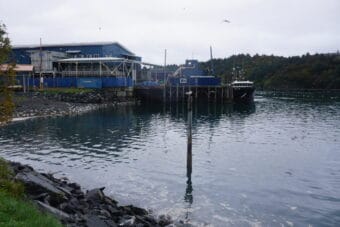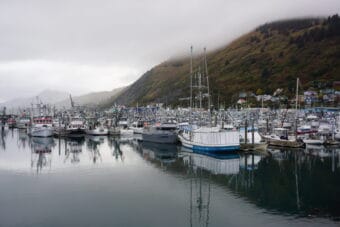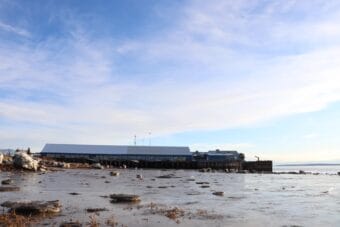
Alaska’s Board of Fisheries this week voted to continue with conservation measures for chronically low returns of king salmon in Southeast Alaska. Some stocks are forecast to be at their lowest levels on record this year and others have rebounded a little under fishery closures.
The region has 34 stocks of king salmon and the board has listed seven as stocks of concern. That means for four years or more, those runs have not had enough fish making it back to spawn, or what managers call an escapement goal.
Ed Jones is an Alaska Department of Fish and Game coordinator specializing in king salmon research. He outlined to the board the measures taken to reduce harvest of those fish.
“Through the actions taken beginning in 2018 with the action plans, we have taken good steps towards achieving the escapement goals,” Jones said. “The problem is the production of these stocks has just continued to be low. And so right now we’ve not been able to provide a harvestable yield annually. The hopes are that that production will change, escapement goals will be met and we’ll also be able to identify yield.”
In 2017, the board named three rivers as stocks of concern: the Chilkat River near Haines; the King Salmon River, the region’s only naturally-occurring island stock on Admiralty Island; and the Unuk River near Ketchikan. In 2020, it added another four: the Stikine River near Wrangell along with one of its tributaries Andrew Creek; the Taku River near Juneau and the Chickamin near Ketchikan.
To reduce harvest of those fish, the winter and spring seasons for the commercial troll fishery have been curtailed. Net fisheries have lost time and area as well. And springtime sport fishing has been shut down on the inside waters of Southeast.
Some of the rivers originate in British Columbia, and the salmon runs are managed under the Pacific Salmon Treaty between the U.S. and Canada. Managers say the restrictions would be likely under that agreement, whether or not Alaska has listed the runs as stocks of concern.
Staffers with Fish and Game sought board direction on the existing conservation measures, as well as additional steps that could curtail harvest further.
During discussion on the Stikine, Max Worhatch of Petersburg, executive director of the United Southeast Alaska Gillnetters, thought the net fishery on the inside waters had lost the most to conservation measures.
“It’s pretty difficult to look at it and hear now from the department they’re considering more restrictions for us in district 6 when right over that line, just west of our line, we have a full-fledged sport fishery going on from Jan. 1 to June 15,” Worhatch said. “We won’t start until after June 15, we’re behind that but we see more restrictions. Pretty hard to take.”
Some fishermen sought a partial reopening of the shortened commercial winter troll season or other lifting of restrictions where fish are rebounding. But many thought conservation measures should continue. Ron Somerville of Juneau is with the Territorial Sportsmen, a sportfishing organization and made that case for the Taku and Stikine rivers.
“I mean when you got stocks that are seven years below the minimum escapement goal, every fish counts,” Somerville said.
Returns for the Taku River near Juneau and Stikine River near Wrangell are forecast to be their lowest on record this year, 6,600 for the Taku and 7,400 for the Stikine. Harvests have been reduced and fishery managers say they’re nearing the limits of what they can do to cut back the catch. Sport and commercial fisheries intercepted 12 percent of the Stikine River run last year and nearly seven percent for the Taku. A small portion of that harvest occurred in Canada.
Some of the other runs are showing improvement. The Chilkat near Haines has met the lower end of its escapement goal for three years although it’s not forecast to make that mark this year. The Unuk has reached that level in three of the past four years and is forecast to again this year. The Situk River near Yakutat is forecast to surpass its escapement goal range.
Board members, like chair Mӓrit Carlson-Van Dort of Anchorage, supported the managers’ efforts.
“I think the department has been doing an excellent job of managing to the conservation concern and at this time I don’t see the need to be more restrictive, I think we’re pretty darn restrictive at this point and I think that the cost to further restriction is very high for what may be not a lot of impact in terms of the conservation,” Carlson-Van Dort said.
The board approved action plans for king salmon stocks of concern. They voted to direct managers to continue with the status quo for fishery conservation measures while allowing managers to use more stringent measures as they see fit.
Board member John Wood of Willow agreed with that direction.
“That is my intent and I don’t consider it punitive madam chairman to the harvesters,” Wood said. “I’m looking more at as much restriction as I can implement, with reasonable on protection of the fish. I mean they’re on their lips already they wouldn’t be in this status if they weren’t in trouble. So, if there’s some economic harm that comes out of that I understand that but I don’t want to be punitive in nature and impose a whole list of different things when it’s not necessary.”
Those action plans have meant sport anglers can’t keep a king salmon starting April 1 on the inside waters and the winter troll fishery ended early March 15.


